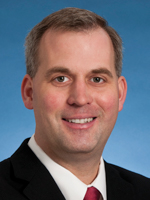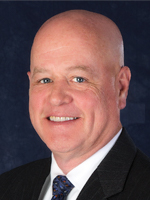Putting pathology at the center of precision medicine
FDA clears Aptima assay for HSV 1 & 2
GenMark ePlex instrument and RP panel cleared
First cancer CDx for Illumina: FDA-approved RAS Panel5
Horizon takes license for transposon-based gene editing platform
PerkinElmer to acquire Euroimmun
Putting pathology at the center of precision medicine
Michael H. Roehrl, MD, PhD, pathologist and director of the Precision Pathology Biobanking Center at Memorial Sloan Kettering Cancer Center, would like to see more joint development of companion diagnostics—pathologists and industry working together. It would lead, in his view, to better companion diagnostics.
“We need to promote the novel idea that pathologists should take part in the design and execution of clinical trials and that we are central to drug development,” he says. Today, as he sees it, companion diagnostics are developed by industry and “imposed on pathologists.”

Dr. Roehri
Dr. Roehrl, an advocate of pathologists practicing “transformative pathology,” designed the Precision Pathology Biobanking Center around five pillars, one of which is becoming a pathology hub for clinical trials. The others are biobanking, precision pathology informatics, new pathology technologies, and R&D commercial partnerships for companion diagnostics.
“The molecular assessment of specimens puts pathologists at the center of enrolling patients in clinical trials,” Dr. Roehrl says. “Basket trials”—focused on specific targetable mutations shared among tumors of different primary sites—“have changed the landscape. Now pathologists must become leaders in those trials.”

Dr. Pfeifer
John D. Pfeifer, MD, PhD, a professor of pathology and immunology and vice chair for clinical affairs in the Department of Pathology at Washington University School of Medicine, agrees, and says pathologists should play a larger role, too, in cancer diagnosis, prognosis, and prediction of effective therapy. More than 250 laboratories already are accredited by the CAP for their use of next-generation sequencing in oncology. “This speaks to the utility of this testing modality for the diagnosis, prognosis, and prediction of therapy,” he says.
“One of the exciting parts of being a pathologist now is the emerging technologies that enable us to provide information that has more utility to our clinical colleagues to optimize patient outcomes,” Dr. Pfeifer says, referring to genetic information and potentially proteomic information from mass spectrometry. “Pathologists are ideally situated to take the lead in this work. We know what’s necessary to design the right tests, and pathologists should be the physicians who interpret the results for our clinical colleagues.”
The MSKCC Precision Pathology Biobanking Center, established in November 2015, carries out translational research in proteomics using liquid chromatography mass spec. “In the next three years we want to look beyond genomics and NGS to proteomics by mass spec,” Dr. Roehrl says. Performing one mass spectrometric analysis on a tumor is like doing 3,000 immunohistochemistry tests in a single run, he says, adding that the latter couldn’t be done even if the laboratory had 3,000 antibodies because mass spec is also fully quantitative.
Modifications at the protein level that can be seen with mass spec cannot be detected by nucleic acid sequencing. That’s important, Dr. Roehrl says, because “virtually all drugs that we have under development act by binding to protein targets. So why not study proteins directly? We can also measure whether protein signaling has changed as we expect it to after exposure to the drug.”
At Washington University, Dr. Pfeifer too, is doing translational research in proteomics using a highly sensitive technique called imaging mass spec, or IMS. “In traditional mass spec we grind up tissue and analyze the whole tumor specimen. In imaging mass spec,” he explains, “a digital image of a conventional glass slide is used to guide mass spec analysis of only those areas of the slide that contain tumor cells, or other cells of interest, using a specialized platform.
“You can get than just which protein and signaling molecules are present.” In effect, he says, the whole metabolome can be seen.
NGS is used in cancer to look for mutations, some of which lead to activation of cell signaling pathways. “There are drugs that block those pathways,” Dr. Pfeifer says. “Many of the mutation events lead to changes in the phosphorylation of proteins, so in effect we do DNA analysis to detect indirectly changes in protein structure that correlate with phosphorylation.”
Does studying tumor tissue by imaging mass spec make it possible to find changes in protein phosphorylation directly? “It is well established that, yes, you can see changes in phosphorylation events by mass spec,” Dr. Pfeifer says. “And we know you can find phosphopeptides by imaging mass spec.” They’re working with collaborators Jeremy Norris, PhD, and Richard Caprioli, PhD, at Vanderbilt University School of Medicine to optimize the technique to map the activation of signaling pathways directly.
“If we can do this, we can go into a cell and look at the full range of activation events, all the relevant phosphopeptides, and get a better indication of which drug therapy would be most helpful.” Imaging mass spec has the potential to be a useful adjunct to NGS, since NGS may not always reveal all relevant alterations. “A cell is a busy place,” as Dr. Pfeifer puts it.
He encourages his colleagues to embrace these technologies. “They’re here to stay. If pathologists don’t take the lead, because of the importance of these tools, some other group will.” —William Check, PhD
Abbott CMV test in U.S.
Abbott’s RealTime CMV molecular test received FDA approval and is now available in the United States. It is the only commercially available CMV test with the ability to amplify two select regions (dual target) of the CMV genome, which helps reduce the risk of under-quantitation or failure to detect the virus.
[hr]
FDA clears Aptima assay for HSV 1 & 2
Hologic has obtained FDA clearance to market the Aptima Herpes Simplex Virus 1 & 2 molecular assay on the fully automated Panther system.
The HSV 1 & 2 assay is a nucleic acid amplification test for the qualitative detection and differentiation of HSV types 1 and 2 in clinician-collected swab specimens from anogenital skin lesions. These samples can be collected using the new Aptima Multitest Swab Specimen Collection Kit or commercially available viral transport media.
[hr]
GenMark ePlex instrument and RP panel cleared
GenMark Diagnostics has received 510(k) market clearance from the FDA for its ePlex instrument and Respiratory Pathogen Panel.
The ePlex platform integrates nucleic acid extraction, amplification, and detection processes into a fully automated sample-to-answer system. The ePlex RP Panel detects more than 20 viral and bacterial pathogens that commonly cause upper respiratory infections.
[hr]
First cancer CDx for Illumina: FDA-approved RAS Panel
Illumina announced its Extended RAS Panel, an FDA-approved next-generation sequencing kit that meets the published guidelines for evaluation of colorectal cancer from the CAP, American Society for Clinical Pathology, Association for Molecular Pathology, and American Society of Clinical Oncology. This kit is intended to be used on the Illumina MiSeqDx system and enables U.S. laboratories to help clinicians identify which patients are eligible for treatment of metastatic colorectal cancer with Vectibix (panitumumab).
The test kit interrogates 56 variants across the KRAS and NRAS genes to establish mutant status in a single test.
“As our first companion diagnostic and PMA approval in oncology, the Extended RAS Panel paves the way for broader-based genomics solutions and brings us closer to realizing the promise of next-generation sequencing in the treatment of patients with cancer,” Francis deSouza, Illumina president and CEO, said in a statement. The panel will begin to ship in the third quarter of this year.
[hr]
Horizon takes license for transposon-based gene editing platform
Horizon Discovery Group has completed licensing agreements with all joint patent holders to provide exclusive worldwide rights to a novel transposon-based gene editing technology platform.
The license broadens Horizon’s gene editing capabilities, with immediate applications in biomanufacturing, diagnostics, and cell therapy. For diagnostics, Horizon can use the technology to efficiently develop reference standards for assays designed to measure the copy number of a gene.
The technology is based on a type of transposon (Helitron), which uses a “copy and paste” mechanism to allow multiple copies of a DNA sequence to be incorporated into a genome, either immediately or by reactivating the transposon machinery to increase the copy number at a later time. This is in contrast to current transposon technologies, which transfer DNA by a “cut and paste” mechanism, where a sequence is removed from one part of a genome and randomly inserted elsewhere.
[hr]
PerkinElmer to acquire Euroimmun
PerkinElmer has entered into a definitive agreement to acquire Euroimmun Medical Laboratory Diagnostics AG. The agreement provides that PerkinElmer will acquire up to a 100 percent stake in Euroimmun. The total purchase price of the transaction based on all outstanding shares being acquired will be about $1.3 billion in cash.
Euroimmun is based in Lübeck, Germany, and has about 2,400 employees. The transaction is anticipated to close in the fourth quarter of this year.
[hr]
Myers named CAP CEO
Stephen R. Myers has been selected to be the new CEO of the CAP.

Myers
“With 14 years of financial and operating leadership experience at the CAP, Stephen is well positioned to build on the organization’s membership strength and financial stability,” CAP president Richard C. Friedberg, MD, PhD, said in announcing the selection last month.
Following a career of public accounting and technology innovation, Myers joined the CAP in 2003 as vice president of finance. He became chief administrative and financial officer in 2011 and has served as chief financial and operating officer since 2013. For the past year, Myers also has served as interim CEO. He holds an MBA from the Kellogg School of Management at Northwestern University and a BBA in accounting from the University of Texas at Austin.
A search committee formed by the CAP Board of Governors selected Myers after an extensive national search. Dr. Friedberg, chair of the search committee, noted that the Board of Governors sought someone with specific skills to partner with the Board to build long-term visionary strategies that exceed member expectations.